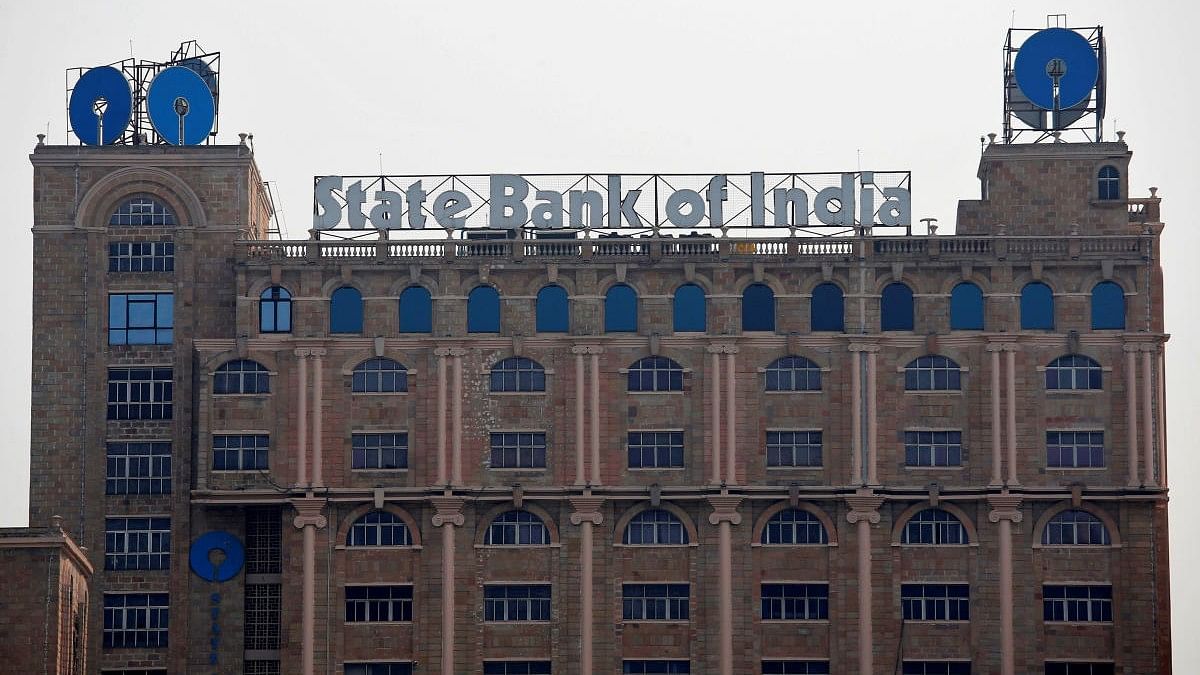
The State Bank of India (SBI) office building.
Credit: Reuters File Photo
Ensuring bond buyers could not be connected to the political parties they gave to was the most important and distinctive design aspect of the electoral bonds.
Data released by the State Bank of India (SBI), the sole issuer and manager of the electoral bonds, on March 21 has busted this key feature. The disclosure also reveals in the open that the SBI was recording the invisible and systemically non-existent alpha-numeric code, embodied in the bonds only for security purposes.
With the security cover of the electoral bonds blown over, many are linking the bond donors with the political parties they donated to. Salacious tales of actual and imagined crony, compromised, and stigmatised capitalism of India have begun coming out in public.
Transparency at both ends — buyers and political parties — of the electoral bonds resulted in substantial political funding, unprecedented in the annals of Indian elections. Busting of secrecy in the middle — the link between the donor and the political party — made the electoral bonds transparent, but has led to its demise.
The SBI has been in the middle of it all.
Breaking the trust
To make sure that the electoral bonds scheme got going without leaving any trace of the link between the donor and the political party, no identification number or other mark was printed on the bonds.
This well-designed plan, however, had one lurking weakness — an invisible alpha-numeric code secretly embedded inside the body of each bond. This was not supposed to exist for the world and even for the SBI. The SBI, the issuer, was not to record this code or any other identifier created by it at the time of issuing and receiving the bonds.
The SBI, which evidently now went beyond its brief, seemed to have fallen for the lure of snooping into the bond to uncover its alpha-numeric code (visible only through an ultraviolet light). It also decided to record it.
From the data revealed by the SBI on March 21, it is quite apparent that it was recording the alpha-numeric code meticulously for each of the electoral bonds issued by it against each buyer at the time of issue, and against the political parties when it was deposited.
The SBI was trusted to ensure that the link between buyers and depositors of the electoral bonds was not established. Unfortunately, it broke this trust by creating an easy audit trail.
Bumbling SBI
On February 15, the SBI was directed by the Supreme Court to disclose the data relating to the denomination, date, and amount of each electoral bond purchased and deposited by March 6. There was no direction to provide any matching link.
The SBI had this data readily available, and could have disclosed the same in a day. Not many either knew about the alpha-numeric numbers at that stage or had demanded it.
The SBI, on its own or at the behest of the government, was perhaps unwilling to disclose the data ordered by the Supreme Court before the completion of the Lok Sabha elections.
So, it now appears that the SBI invented a ruse.
It filed a petition in the Supreme Court two days before the deadline seeking time until June 30. To make its request sound credible, the bumbling SBI averred that this time was required to match buyers of bonds with depositing political parties from the data kept in sealed covers in two separate physical silos.
The excuse was quite ludicrous, and it hinted that there was a matchmaker and brought the cat of alpha-numeric numbers out of the bag.
The excuse did not wash. Everyone believed that the SBI invented this excuse to postpone the disclosure of data on the electoral bonds going public. It got an earful from the Supreme Court and a clear direction to disclose alpha-numeric numbers by March 21.
The bumbling SBI panicked. In the next three days, it disclosed the alpha-numeric code of each electoral bond for its buyers and political parties.
The link between the buyer and depositor of each electoral bond was publicly disclosed. Thereafter, it required only a few Excel sheet clicks to match each bond donor with the political party.
It baffles me why the bank offered to do this matching in the first place. Also, why was about four months asked to do a simple matching exercise which any rooky computer analyst could do in a couple of hours?
The SBI has proved to not only illegally record transaction details, but has also been a bumbling manager-trustee.
What now?
Unfortunate as it may be for the companies and individuals who contributed handsomely to the electoral funding trusting the design and features of the pragmatically transparent electoral bonds, the baby stands thrown out with the bath water. The electoral bonds are history now.
A part of the story, however, is still under wraps. Information about the alpha-numeric numbers for the electoral bonds purchased and deposited between March 2018 and April 11, 2019, are still not in the open.
Let the Election Commission of India ask the SBI to disclose this data as well so that there is a completely level playing field for all the electoral bonds of about Rs 16,200 crore issued and deposited in its six-year life.
(Subhash Chandra Garg is former Finance & Economic Affairs Secretary, and author of ‘The Ten Trillion Dream’ and ‘We Also Make Policy’.)
Disclaimer: The views expressed above are the author's own. They do not necessarily reflect the views of DH.